NHSScotland Chief Executive's Annual Report 2011/12
The NHSScotland Chief Executive's Annual Report 2011/12 presents an assessment of the performance of NHSScotland in 2011/12 and describes key achievements and outcomes.
CHAPTER 2 SUMMARY OF KEY ACHIEVEMENTS
KEY ACHIEVEMENTS 2011/12
NHSScotland delivered a number of significant and important achievements during 2011/12, and made further progress towards our vision for world-leading healthcare services and a healthier Scotland. These achievements include specific progress towards the national targets agreed for NHSScotland in 2011/12, and a range of broader quality improvements.
Each year, after extensive consultation, the Scottish Government sets performance targets for NHS Boards to ensure that the resources made available to them are directed to priority areas for improvement, consistent with the Government's Purpose[5] and National Outcomes[6], and with the strategic direction set out in the Quality Strategy. These targets are focused on Health Improvement, Efficiency, Access and Treatment, and are known collectively as HEAT targets.
Our HEAT targets for NHSScotland set out the priorities for accelerated improvement to support the delivery of improved health and wellbeing outcomes for the people of Scotland. NHSScotland has delivered notably strong performance against the safe, effective and person-centred Quality Ambitions in a number of areas:
- delivery of the 18-week Referral to Treatment waiting time target, after a four-year improvement programme;
- delivery of cancer waiting times targets, including the additional target set in 2008 to reduce the time between the decision to treat and treatment to 31 days;
- achieving significant reductions in levels of Healthcare Associated Infections (HAI), with a 24 per cent reduction in Clostridium difficile and a 10 per cent reduction in MRSA/MSSA in 2011/12. Between 2007/08 and 2011/12 there has been a cumulative fall of 78 per cent in Clostridium difficile and 35 per cent in MRSA/MSSA;
- completing over 272,000 Alcohol Brief Interventions to help tackle harmful and hazardous drinking over the last four years; growing from 30,310 in 2008/09 to 55,757 in 2009/10, 88,138 in 2010/11 and a high of 97,830 in 2011/12;
- delivering almost 48,000 inequalities targeted cardiovascular health checks in 2011/12, building on the almost 71,000 delivered during 2009/10 and 2010/11;
- reducing the rate of emergency bed days for people aged 75 and over by 7.6 per cent between 2009/10 and 2011/12, and by 10.9 per cent since 2006/07;
- a reduction in Scotland's suicide rate of 17 per cent between 2000/02 and 2009/11, including a 4 per cent reduction since 2005/07;
- year-on-year reductions in NHS staff sickness absence, from 5.55 per cent in 2006/07 to 4.63 per cent in 2011/12;
- a reduction in Hospital Standardised Mortality Ratios (HSMR) of 2.7 per cent in 2011/12 and a total of 10.6 per cent between October-December 2007 and January-March 2012;
- further reductions in levels of premature mortality (deaths for those aged under 75) across Scotland of 2 per cent in 2011 and 12 per cent since 2007;
- reduction in deaths from cancer, stroke and Coronary Heart Disease (CHD) since 2007 by 5 per cent, 24 per cent and 20 per cent respectively, including a 1 per cent, 5 per cent and 8 per cent reduction in 2011 alone;
- achieving financial balance for every NHS Board; and
- Over £1 billion of efficiency savings has been reinvested in the NHS across Scotland to boost front-line care for patients between 2008/09 and 2011/12.
Information on progress towards all of the HEAT targets for NHSScotland is available for public scrutiny through the Scottish Government website Scotland Performs[7], including those targets referred to above. This is updated on a continuous basis and includes both national and NHS Board level information.
HEAT TARGETS 2011/12
HEALTH IMPROVEMENT FOR THE PEOPLE OF SCOTLAND
| HEAT Targets Due for Delivery in 2011/12 | |
|---|---|
| Target | Outcome |
| Achieve agreed number of screenings using the setting-appropriate screening tool and appropriate Alcohol Brief Intervention, in line with SIGN 74 Guideline during 2011/12. | 97,830 Alcohol Brief Interventions delivered, against a target of 61,081. |
| Achieve agreed number of inequalities targeted cardiovascular health checks during 2011/12. | 47,776 targeted health checks delivered, against a target of 26,682. |
| HEAT Targets Due in Future Years | |
| Target | Latest Results |
| Reduce suicide rate between 2002 and 2013 by 20 per cent. | Between 2000/02 and 2009/11 the rate of suicide has decreased by 16.7 per cent, from 17.4 per 100,000 population to 14.5 per 100,000 population. |
| To achieve 14,910 Child Healthy Weight Interventions over the three years ending March 2014. |
5,052 Child Healthy Weight Interventions delivered during 2011/12. |
| NHSScotland to deliver universal smoking cessation services to achieve at least 80,000 successful quits (at one month post quit) including 48,000 in the 40 per cent most-deprived within-Board SIMD areas over the three years ending March 2014. | 24,529 successful one month quit attempts in the 40 per cent most-deprived areas during 2011/12. |
| At least 60 per cent of 3 and 4 year olds in each SIMD quintile to have fluoride varnishing twice a year by March 2014. | First results to be published in November 2012. |
EFFICIENCY AND GOVERNANCE IMPROVEMENTS
| HEAT Targets Due for Delivery in 2011/12 | |
|---|---|
| Target | Outcome |
| NHS Boards to operate within their agreed revenue resource limit; operate within their capital resource limit; meet their cash requirement. | All NHS Boards met their 2011/12 financial targets. |
| NHS Boards to deliver a 3 per cent efficiency saving to reinvest in frontline services. | NHS Boards delivered local Efficient Government savings of £313 million, representing 3.6 per cent of baseline funding. |
| HEAT Targets Due in Future Years | |
| Target | Latest Results |
| NHSScotland to reduce energy-based carbon emissions and to continue a reduction in energy consumption to contribute to the greenhouse gas emissions reduction targets set in the Climate Change (Scotland) Act 2009. | Between 2009/10 and 2011/12, NHSScotland secured a 2.6 per reduction in CO2 emissions and a 2.1 per cent reduction in energy consumption. |
ACCESS TO SERVICES
| HEAT Targets Due for Delivery in 2011/12 | |
|---|---|
| Target | Outcome |
| From the quarter ending December 2011, 95 per cent of all patients diagnosed with cancer to begin treatment within 31 days of decision to treat, and 95 per cent of those referred urgently with a suspicion of cancer to begin treatment within 62 days of receipt of referral. | In January to March 2012, 94.8 per cent of patients urgently referred with a suspicion of cancer began treatment within 62 days of urgent referral, increasing to 95.3 per cent in April to June 2012. In January to March 2012, 97.9 per cent of patients diagnosed with cancer started treatment within 31 days of their decision to treat, increasing to 98.0 per cent in April to June 2012. |
| Deliver 18-weeks referral to treatment from 31 December 2011. |
In December 2011, 92.0 per cent of patients were seen within 18 weeks. NHSScotland has consistently maintained this performance, with 92.4 per cent seen within 18 weeks during June 2012. |
| HEAT Targets Due in Future Years | |
| Target | Latest Results |
| By March 2013, 90 per cent of clients will wait no longer than 3 weeks from referral received to appropriate drug or alcohol treatment that supports their recovery. | In the quarter ending June 2012, 90.0 per cent of clients who had started their first treatment for drug or alcohol use had waited 3 weeks or less. |
| Deliver faster access to mental health services by delivering 26-weeks referral to treatment for specialist Child and Adolescent Mental Health Services (CAMHS) from March 2013; and 18-weeks referral to treatment for psychological therapies from December 2014. | Waiting times information for CAMHS is at an early stage of development. Initial estimates indicate that around 92 per cent of people were seen within 26 weeks during the quarter ending June 2012. National data systems for 18-weeks referral to treatment for psychological therapies are currently being established. |
TREATMENT APPROPRIATE TO INDIVIDUALS
| HEAT Targets Due for Delivery in 2011/12 | |
|---|---|
| Target | Outcome |
| Reducing the need for emergency hospital care, NHS Boards will achieve agreed reductions in emergency inpatient bed days rates for people aged 75 and over between 2009/10 and 2011/12 through improved partnership working between the acute, primary and community care sectors. | Between 2009/10 and 2011/12 there was a 7.6 per cent decrease in the rate of occupied bed days for patients aged 75+ from 5,390 bed days per 1,000 population to 4,980. |
| HEAT Targets Due in Future Years | |
| Target | Latest Results |
| To improve stroke care, 90 per cent of all patients admitted with a diagnosis of stroke will be admitted to a stroke unit on the day of admission, or the day following presentation by March 2013. | 78 per cent of patients admitted with a diagnosis of stroke in 2011 were admitted to a stroke unit within one day of admission. |
| Further reduce Healthcare Associated Infections so that by March 2013 NHS Boards' Staphylococcus aureus bacteraemia (including MRSA) cases are 0.26 or less per 1000 acute occupied bed days; and the rate of Clostridium difficile infections in patients aged 65 and over is 0.39 cases or less per 1000 total occupied bed days. | For the year ending June 2012, the rate of Staphylococcus aureus bacteraemia (including MRSA) cases across NHSScotland was 0.30 per 1,000 acute occupied bed days. The rate of CDI was 0.30 per 1,000 occupied bed days among patients aged 65 and over. |
| To support shifting the balance of care, NHS Boards will achieve agreed reductions in the rates of attendance at A&E between 2009/10 and 2013/14. | In the year ending June 2012, the number of unplanned A&E attendances per 100,000 population was 2,183 (the target for 2013/14 is 2,095). |
LONGER-TERM PROGRESS
The achievements of the NHS in Scotland during 2011/12 should not be seen isolation. For a number of years, NHSScotland has made continual and steady improvements in the service it delivers, and as a result has secured better outcomes for the people of Scotland. This gives NHSScotland a strong foundation on which to deliver further progress in future, as it works towards the aims of the 2020 Vision.
One of the most significant achievements is the fall in premature mortality in the past 20 years, which has decreased by over a third (Chart 1). This includes a 2 per cent decrease in the latest year alone. Premature mortality, a key indicator of the health of Scotland's population, measures the death rates of those aged under 75. In 1991, there were 540 deaths for every 100,000 people aged under 75. By 2011, the figure had fallen to 349.
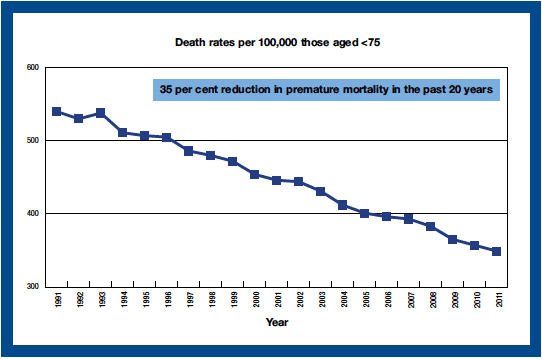
Source: National Records of Scotland: Under 75 Age Standardised Deaths Rates
We have made significant progress in reducing waiting times with the introduction of the 18-weeks Referral to Treatment times Standard (Chart 2). Reduced waiting times help to sustain a better quality of life for patients and help achieve the objective of a Healthier Scotland. The 18-weeks standard is different from previous targets because it applies to the whole 'pathway' from referral up to the point that the patient is actually treated. From January 2011 to June 2012, the percentage of patients treated within 18 weeks has increased from 82.1 per cent to 92.4 per cent. A standard of 90 per cent has applied since December 2011.
Analysing one of the main constituent parts of the referral to treatment journey we see median waits for inpatient and day case admissions has reduced from 35 days in the quarter ending March 2008 to 25 days in the quarter ending June 2012.
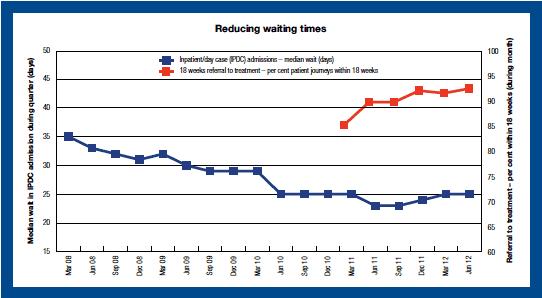
Source: NHS Information Services Division: Waiting Times 18-week Referral to Treatment, Waiting Times Data Warehouse
For many years there have also been specific waiting times targets for the treatment of cancer, which is the most common cause of premature mortality in Scotland. Since 2007 the NHS has made great progress in delivering faster access to cancer treatment services, under both the old and new 62-day targets (where 95 per cent of patients should begin treatment within 62 days of a first referral). In the quarter ending June 2012, 95.3 per cent of patients began treatment within 62 days of a first referral (Chart 3).
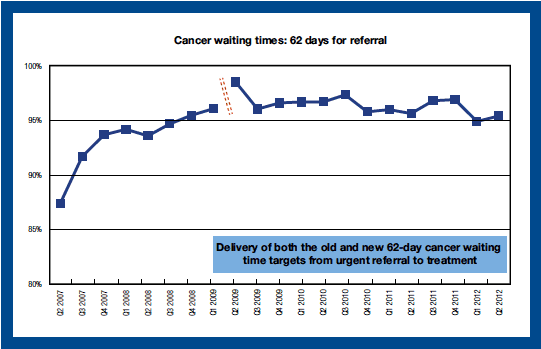
Source: NHS Information Services Division Waiting Times: Cancer Waiting Times
Whist overall premature mortality has fallen since 1991, the number of alcohol-related deaths has increased sharply during this time, more than doubling from 624 to 1,247 in 2011[8] (despite a 5 per cent decrease between the latest two years). It is vital that reduced waiting times be secured for the treatment of people with drug and alcohol addiction problems and NHSScotland was set a 90 per cent target to deliver a three-week referral to drug/alcohol treatment by March 2013. Such has been the level of progress secured by the NHS, that the target has been delivered nine months early, with 90 per cent of people starting their first treatment within three weeks during April to June 2012 (Chart 4).
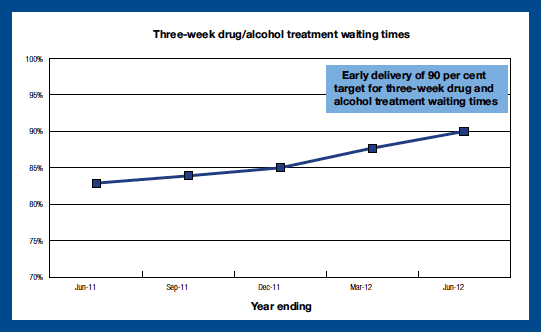
Source: NHS Information Services Division: National Drug and Alcohol Treatment Waiting Times
Once people begin their treatment, they should expect the highest standard of quality and safety. One of the ways in which NHSScotland has sought to achieve this over a number of years is through reducing the level of Healthcare Associated Infections (HAI). These events can increase patient stays in hospital, leading to poorer outcomes. In 2007/08 there were 6,516 cases of Clostridium difficile amongst patients aged 65 and over, a rate of 1.32 cases per 1,000 occupied bed days (Chart 5). Thanks to a huge effort by NHS Boards and staff, this has dropped by 78 per cent to 1,443 cases in 2011/12, or a rate of 0.30 cases per 1,000 bed days.
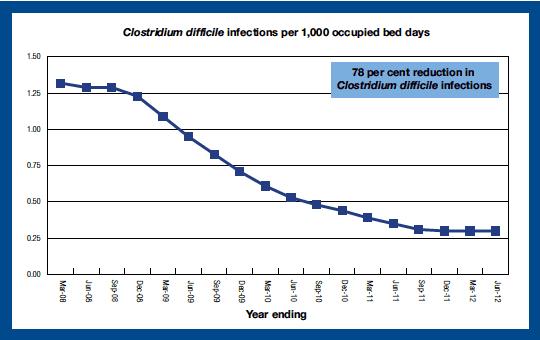
Source: Health Protection Scotland: Quarterly Report on CDI
Once patients are ready to be discharged from hospital, they should expect this to happen as soon as possible. Unnecessary delays contribute to a poorer experience for patients and are a waste of hospital resources. Over the past 10 years, NHSScotland has made huge progress in speeding up discharge. Back in April 2002, there were almost 2,000 patients delayed in hospital by over six weeks (Chart 6). By July 2012 that figure had dropped by over 97 per cent to just 50. Building on this success, NHSScotland has a new target for a 28-day maximum wait for discharge, to be achieved by April 2013, and a 14-day maximum wait by April 2015.
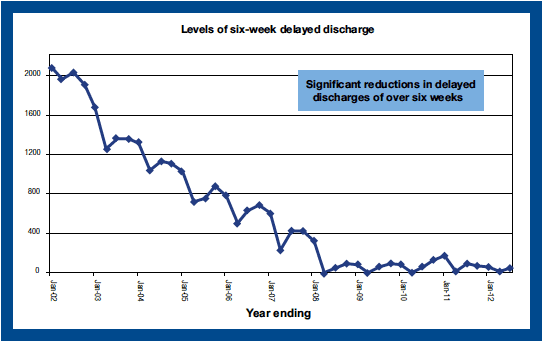
Source: NHS Information Services Division: Delayed Discharge
The direct experience of people who use the NHS in Scotland will always be crucial in determining how effectively services are being delivered. Better Together is a national initiative that feeds the experiences of the public into the improvements of the NHS. The latest results from these surveys demonstrate that NHSScotland currently enjoys a favourable reputation amongst its users. In 2011/12, 85 per cent of inpatients and 89 per cent of GP patients rated their care as either good or excellent (Chart 7).
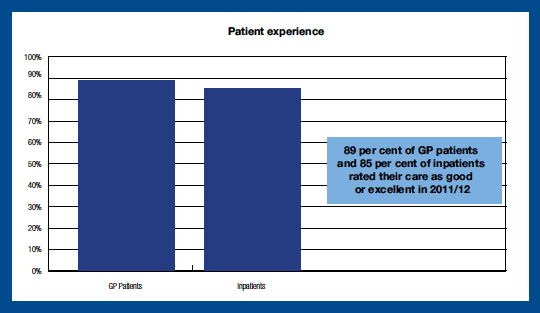
Source: Scottish Government: Better Together Scottish Patient Experience Survey of GP and Local NHS Services/Scottish Inpatient Patient Experience Survey
Sustained investment in the NHS will ensure Boards continue to have the necessary resources to bring about real benefits to both patients and staff, and that a first class service can be delivered to patients across the country. Over the past four years, NHSScotland has been asked to make efficiency savings, so money can be reinvested where it is needed most. Between 2008/09 and 2010/11, NHSScotland made £694 million of Efficient Government savings, with a further £369 million of savings secured in 2011/12. Altogether, this means over £1 billion has been reinvested in front-line care in NHSScotland during the past four years.
Contact
Email: Andrew Wilkie
There is a problem
Thanks for your feedback